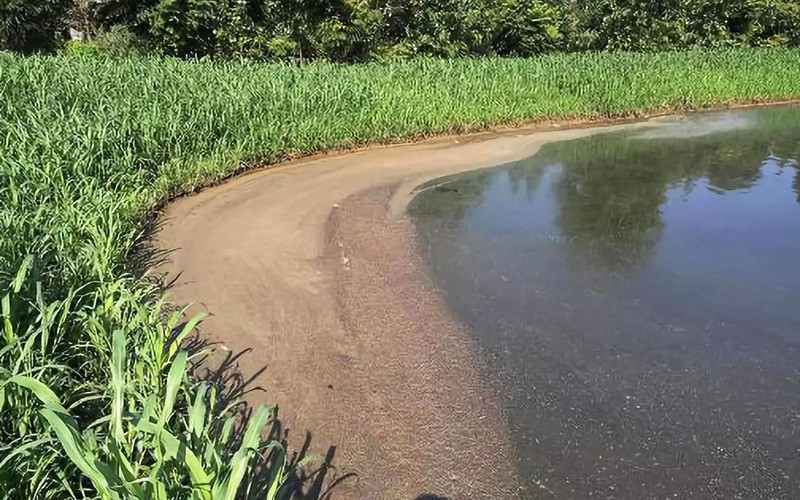How to deal with pond bottom overturning?
Pond bottom return is a common aquaculture problem, mainly due to excessive accumulation of organic matter at the bottom of the pond, resulting in deterioration of water quality.
Here are some ways to deal with pond bottom return:
1. Improve the bottom environment: Bottom deterioration is one of the main reasons for the bottom return phenomenon. It is necessary to do a good job of bottom improvement in time to promote the decomposition and purification of organic matter at the bottom. Some bottom improvement products, such as oxidizing bottom improvement products, can be used to help improve the bottom quality and reduce the production of harmful substances.
2. Timely test water quality: The bottom return phenomenon is often related to water quality problems, so it is necessary to regularly check the pH value, ammonia nitrogen, nitrite and other indicators in the water. If the water quality indicators are found to be abnormal, timely measures should be taken to adjust them, such as using biological agents, changing water, etc.
3. Pay attention to pond oxygenation and shrimp nutrition: Ensure that there is sufficient dissolved oxygen in the water to reduce the bottom return problem caused by hypoxia. It is necessary to strengthen the maintenance of shrimps, provide them with sufficient nutrition and oxygen, and promote their growth and recovery. Some nutrients, such as vitamins (multi-dimensional pioneers), amino acids, etc., can be used to enhance the immunity and vitality of shrimps.
4. Clean the pond regularly: Regularly cleaning the pond can effectively remove residual bait and shrimp excrement and reduce water pollution.
5. Use water quality improvers: When necessary, you can use some water quality improvers, such as bottom modification products, to help improve the bottom quality and reduce the production of harmful substances, thereby reducing the possibility of shrimp and crabs climbing on the grass and landing on the shore.
6. Regularly test the water quality: Regularly test the water quality, understand the changes in water quality, and adjust the breeding strategy in time to avoid shrimp and crabs climbing on the grass and landing on the shore due to water quality problems.
In general, the key to dealing with pond bottom return is to improve the bottom environment, maintain good water quality, pay attention to pond oxygenation and shrimp nutrition, clean the pond regularly, use water quality improvers, and test the water quality regularly. At the same time, we should also pay attention to the maintenance of the bottom of the pond, clean it regularly, and prevent the occurrence of bottom pollution.
池塘返底怎么处理?
池塘返底是一种常见的养殖问题,主要是由于池塘底部的有机物质积累过多,导致水质恶化。以下是一些处理池塘返底的方法:
1、改善底质环境:底质恶化是返底现象的主要原因之一,一定要及时做好改底工作,促进底部有机物的分解和净化。可以使用一些底改产品,如氧化性的底改产品,帮助改善底质,减少有害物质的产生。

2、及时检测水质:反底现象往往与水质问题有关,因此要定期检查水中的pH值、氨氮、亚硝酸盐等指标。如果发现水质指标异常,要及时采取措施进行调整,例如使用生物制剂、换水等。
3、注意池塘增氧和虾的营养:确保水中溶氧量充足,以减少因缺氧导致的反底问题。要加强对虾的养护,为其提供充足的营养和氧气,促进其生长和康复。可以使用一些营养物质,如维生素(多维先锋)、氨基酸等,来增强对虾的免疫力和生命力。
4、定期清理池塘:定期清理池塘,可以有效去除残余饵料和虾的排泄物,减少水质污染。

5、使用水质改良剂:在必要的时候,可以使用一些水质改良剂,如底改产品,帮助改善底质,减少有害物质的产生,从而降低虾蟹上草上岸的可能性。
6、定期检测水质:定期检测水质,了解水质的变化情况,及时调整养殖策略,避免因水质问题导致虾蟹上草上岸。
总的来说,处理池塘返底的关键在于改善底质环境,保持良好的水质,注意池塘增氧和虾的营养,定期清理池塘,使用水质改良剂,定期检测水质。同时,也要注重池塘底部的维护,定期清理,预防底部污染的发生。

